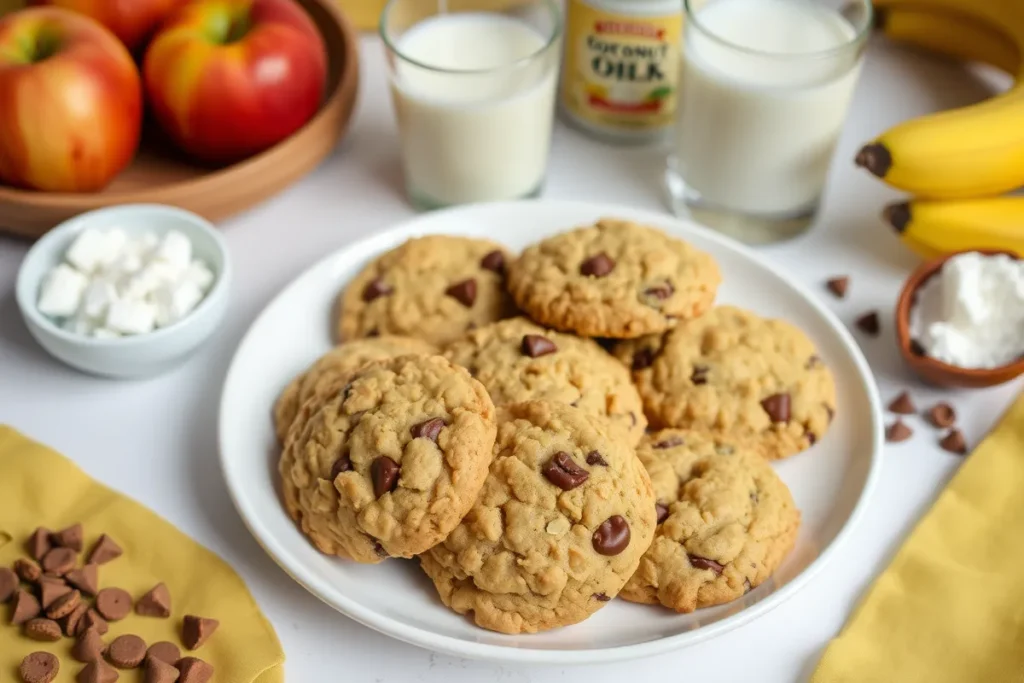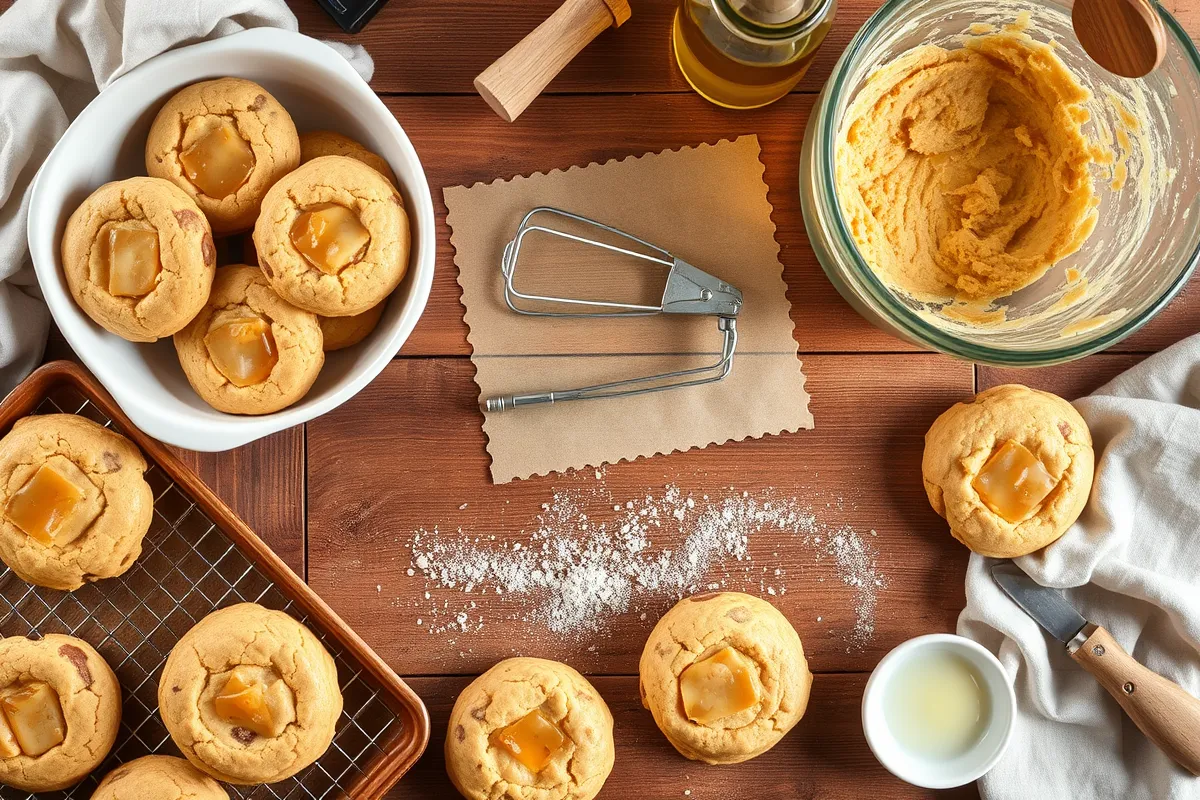Introduction
Butter is a beloved ingredient in cookie recipes, known for its rich flavor and ability to create the perfect texture. But what if you find yourself without butter or prefer not to use it? The good news is, there are plenty of substitutes that can produce equally delicious results. Whether you’re looking for a dairy-free option, trying to cut down on saturated fats, or simply out of butter, there are many ways to bake cookies without it.
Baking cookies without butter doesn’t mean sacrificing flavor or texture. In fact, some substitutes may even enhance certain recipes, giving them a unique twist. This guide explores several alternatives and responds to the question: What can I use to bake cookies without butter ?, from oils and fruit purees to dairy-free options. You’ll also find practical tips to ensure your cookies turn out perfect every time.
Using substitutes for butter is easier than you might think. With a little creativity and understanding of each option, you can transform your cookie recipes into something just as delightful. Let’s dive in to discover the best ways to bake cookies without butter and how each substitute works.
Understanding the Role of Butter in Cookies
Butter plays a vital role in cookie recipes, affecting flavor, texture, and overall baking results. Understanding why butter is so important helps you make better choices when using substitutes. Let’s explore its key contributions to cookies.
Flavor Enhancement
Butter is known for its rich, creamy flavor that enhances the taste of cookies. Its natural fats help carry flavors, making every bite indulgent and satisfying. When replacing butter, it’s essential to consider substitutes that offer a similar richness or complement the flavor profile of your recipe.
Texture and Moisture Contribution
The fat in butter creates a tender, melt-in-your-mouth texture. It adds moisture, ensuring that cookies remain soft and chewy rather than dry or crumbly. When selecting a substitute, choose one that mimics this characteristic to maintain the desired consistency.
Impact on Cookie Spread and Structure
Butter influences how cookies spread during baking. Its water content turns to steam in the oven, helping cookies rise and form a light structure. Substitutes like oils or shortenings may alter this behavior, so adjustments in dough consistency or baking temperature might be necessary.
By understanding these aspects, you’ll be better equipped to choose the right alternative for butter, ensuring your cookies remain delicious and texturally satisfying.
Top Butter Substitutes for Baking Cookies
What can I use to bake cookies without butter is a question that is entirely possible, and several substitutes can replicate its role effectively. Each option has unique properties that impact flavor, texture, and baking results. Let’s explore the most popular butter substitutes and how to use them.
Margarine
Margarine is a common butter alternative that closely mimics its flavor and texture. Made from vegetable oils, margarine is widely available and easy to use.
- How to Use: Substitute margarine for butter in a 1:1 ratio. Ensure you choose a stick form for baking rather than spreadable margarine, which contains more water and can alter the dough consistency.
- Key Tips: Margarine may affect the flavor slightly, so consider adding a splash of vanilla extract to enhance the taste. Be cautious of trans fats in some margarine brands, and opt for healthier varieties when possible.
Shortening
Shortening is another effective substitute, especially for creating tender, flaky cookies. Unlike butter, shortening is made entirely of fat, with no water content.
- How to Use: Replace butter with shortening in a 1:1 ratio. To mimic butter’s flavor, you can add a pinch of salt or a small amount of butter extract.
- Key Tips: Shortening doesn’t provide the same rich taste as butter, but it excels in producing cookies with a soft texture and minimal spread.
Oils
Oils are versatile substitutes for butter, offering a wide range of flavor and texture options. Three popular choices are vegetable oil, olive oil, and coconut oil.
Vegetable Oil
- How to Use: Replace butter with vegetable oil in a 1:1 ratio. Its neutral flavor works well in most cookie recipes.
- Key Tips: Oil-based cookies may spread more, so chilling the dough before baking can help control the shape.
Olive Oil
- How to Use: Use olive oil in a 3:4 ratio (e.g., ¾ cup olive oil for 1 cup of butter). This substitution is ideal for cookies with a savory or unique flavor profile.
- Key Tips: Olive oil adds a distinct taste, making it best for recipes where its flavor complements the ingredients.
Coconut Oil
- How to Use: Substitute coconut oil for butter in a 1:1 ratio. Solid coconut oil works similarly to butter in recipes.
- Key Tips: Coconut oil adds a subtle tropical flavor, which pairs well with chocolate chip or oatmeal cookies. Ensure it’s at room temperature for easier mixing.
Fruit Purees
Fruit purees are a healthier alternative to butter, adding moisture and natural sweetness to cookies. They work particularly well in recipes where a softer, denser texture is desired. Common options include applesauce, mashed bananas, and pumpkin puree.
Applesauce
- How to Use: Replace butter with unsweetened applesauce in a 1:1 ratio. Applesauce adds moisture while reducing the overall fat content.
- Key Tips: Cookies made with applesauce may have a softer texture and a slightly fruity flavor. To balance the sweetness, reduce the sugar in the recipe slightly.
Mashed Bananas
- How to Use: Substitute mashed bananas for butter in a 1:1 ratio. This option works best in cookies that pair well with a mild banana flavor, like chocolate or oatmeal.
- Key Tips: The natural sweetness of bananas can alter the flavor, so choose ripe bananas for the best results. Bananas also add density, so these cookies may not be as crisp.
Pumpkin Puree
- How to Use: Use pumpkin puree in a 1:1 ratio as a butter replacement. It’s perfect for fall-themed cookies, adding a subtle pumpkin flavor and bright orange color.
- Key Tips: Pumpkin puree can make cookies softer and chewier. To enhance the flavor, consider adding spices like cinnamon, nutmeg, or ginger.
Dairy Alternatives
For those who prefer a creamy, tangy substitute, dairy alternatives like Greek yogurt and buttermilk are excellent choices. They add moisture and richness to cookies without the need for butter.
Greek Yogurt
- How to Use: Replace butter with plain Greek yogurt in a 1:1 ratio. Use full-fat yogurt for the best results in texture and richness.
- Key Tips: Greek yogurt adds tanginess, which pairs well with fruity or spiced cookies. Adjust the dough’s consistency by adding a tablespoon of flour if it feels too wet.
Buttermilk
- How to Use: Substitute butter with buttermilk in a 3:4 ratio (e.g., ¾ cup buttermilk for 1 cup of butter). It’s best for soft, fluffy cookies.
- Key Tips: Since buttermilk is a liquid, you may need to reduce other liquid ingredients in the recipe to maintain the correct dough consistency.
Nut Butters
Nut butters, like peanut butter and almond butter, are flavorful and nutrient-rich substitutes for butter. They add a creamy texture and a distinct taste, making them an excellent choice for certain types of cookies.
Peanut Butter
- How to Use: Replace butter with peanut butter in a 1:1 ratio. Creamy peanut butter works best for a smooth texture, while chunky peanut butter adds a delightful crunch.
- Key Tips: Peanut butter cookies may spread less than those made with butter. To enhance their richness, consider adding a small amount of oil or margarine.
Almond Butter
- How to Use: Use almond butter in a 1:1 ratio as a butter substitute. Its mild, nutty flavor complements recipes like oatmeal or chocolate cookies.
- Key Tips: Almond butter may alter the consistency of the dough slightly, so chilling it before baking can help maintain the cookie’s shape. Add a pinch of salt to balance the flavors if needed.
Nut butters are especially great for gluten-free or protein-packed cookies, making them a versatile option for health-conscious bakers.
How to Choose the Right Substitute
Selecting the perfect butter substitute for your cookies depends on several factors, including flavor, texture, dietary preferences, and availability. Here’s how to make the best choice for your recipe.
Consider the Flavor Profile
Each substitute has a unique flavor that can enhance or change the overall taste of your cookies. For example:
- Neutral substitutes: Vegetable oil and margarine are ideal for recipes where you want the other ingredients, like chocolate or spices, to stand out.
- Bold flavors: Coconut oil, peanut butter, or olive oil can add distinctive tastes. These work best in recipes where their flavors complement the cookie, such as oatmeal or spiced cookies.
Evaluate Texture Needs
Butter contributes to the chewy, crispy, or tender texture of cookies. Depending on your preference, choose a substitute that aligns with your texture goals:
- For soft and chewy cookies, fruit purees or Greek yogurt are excellent options.
- For crispy cookies, shortening or coconut oil works well because of their solid fat content.
Account for Dietary Considerations
If you’re baking for specific dietary needs:
- Use dairy-free options like oils or margarine for vegan cookies.
- Opt for lower-fat alternatives such as applesauce or mashed bananas for a healthier twist.
Think About Availability and Cost
The best substitute is often the one you already have in your kitchen. Oils, fruit purees, or margarine are affordable and commonly available, making them convenient choices.
Test and Adjust
When experimenting with substitutes, test small batches to understand how the changes affect your recipe. Adjust the dough consistency, baking time, or temperature if needed.
By considering these factors, you can confidently choose the ideal substitute for butter, ensuring delicious cookies that meet your needs.
Practical Tips for Baking Cookies Without Butter
Baking cookies without butter can be a smooth and successful experience when you follow a few practical tips. These guidelines will help you achieve delicious results, regardless of the substitute you choose.

Adjust Baking Times and Temperatures
Butter substitutes can affect the baking process. For example:
- Oil-based substitutes: Cookies may bake faster due to the higher liquid content. Check them a few minutes earlier than the recipe suggests.
- Fruit purees and nut butters: These may take slightly longer to set because they retain more moisture. Keep an eye on the edges to ensure they don’t overbake.
Monitor Dough Consistency
Substitutes like oil and yogurt can change the texture of your dough. To maintain the right consistency:
- If the dough feels too sticky, add a tablespoon of flour at a time until it’s manageable.
- For dry dough, incorporate a small amount of milk, water, or additional oil to balance it out.
Chill the Dough
Certain substitutes, such as coconut oil or nut butters, can make the dough softer than usual. Chilling the dough for 30 minutes before baking can help cookies hold their shape and prevent excessive spreading.
Enhance Flavor Profiles
Some substitutes may not provide the same richness as butter. Enhance your cookies with:
- Vanilla or almond extracts: Add a teaspoon to boost the overall flavor.
- Spices: Cinnamon, nutmeg, or cardamom can complement the substitute you’re using.
- Add-ins: Mix in chocolate chips, dried fruits, or nuts to create more depth and texture.
Store Cookies Properly
Cookies made without butter may have a different shelf life. To keep them fresh:
- Store soft cookies in an airtight container with a slice of bread to retain moisture.
- For crisp cookies, use a container with a loose lid to maintain their texture.
By keeping these tips in mind, you can bake cookies without butter that taste just as good—if not better—than traditional recipes.
Conclusion
Baking cookies without butter opens up a world of possibilities, allowing you to experiment with new flavors and textures while accommodating dietary needs or ingredient availability. From oils and fruit purees to nut butters and dairy alternatives, there’s no shortage of creative options to explore.
By choosing the right substitute depending on your recipe and personal preferences, you prove that the common question of What can I use to bake cookies without butter is in fact realisable. Whether you want soft and chewy cookies with applesauce, crispy cookies with shortening, or rich and nutty cookies with peanut butter, each alternative offers unique benefits. Understanding the role of butter and how substitutes interact with other ingredients ensures your cookies turn out delicious every time.
Remember to adjust baking times, monitor dough consistency, and enhance flavors when using substitutes. Small tweaks can make a significant difference, resulting in cookies that taste just as good—if not better—than those made with butter.
Now that you know how to bake cookies without butter, you’re ready to get creative in the kitchen. Experiment with these substitutes and discover new favorite recipes that cater to your needs and preferences. Happy baking!
We also covered in a previous article, the question of: Can I Use Protein Powder Instead of Flour for Cookies? Make sure you take a look at it.

